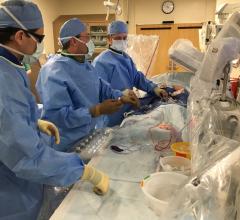May 19, 2016 — Physician-researchers in the College of Medicine at the University of Cincinnati have developed a computerized decision support tool to assist physicians and patients with decisions about blood thinning treatment to prevent strokes in individuals with atrial fibrillation.
They have used the decision support tool, which uses a combination of patient information and characteristics, to review medical therapies for 1,876 patients in the primary care network at UC Health as part of a one-year cluster randomized clinical trial, explained Mark Eckman, M.D., Posey Professor of Clinical Medicine. Half of the patients were cared for by physicians who were given access to the computerized model while a control group of patients had physicians who did not have access to the model.
Physicians were not required to use the computerized model, but among the subgroup of doctors who did, the number of patients who had medical therapies that differed from what was recommended by the model dropped from 63 percent to 59.1 percent. That change in prescribed medical therapies is considered clinically and statistically significant, said Eckman.
That advantage disappears when comparing the full cohort of patients whose doctors received access to the model and chose to use or not use it to those patients whose doctors were not given access and were part of the trial’s control group. The findings were presented at the annual meeting of the Society of General Internal Medicine.
The computerized model is known as the Atrial Fibrillation Decision Support Tool. The Heart Rhythm Society has awarded a $250,000 grant to Eckman for his research related to the use of this tool. Funding of this grant will be provided by Boehringer-Ingelheim Corp.
“The tool is essentially a decision analytic model that we have integrated into our electronic health record and so it automatically pulls information about patients with atrial fibrillation and from that information is able to calculate for the individual patient their risk of AF-related stroke and major bleeding while taking blood thinning therapy,” said Eckman, also director of the UC Division of General Internal Medicine and a UC Health physician.
“There is a risk of major bleeding on blood thinning therapy and the tool basically delivers a recommendation based on the balance of risk and benefit indicating whether a patient on average would do better with blood thinning therapy versus without,” Eckman added.
The decision support tool uses the patient’s age, gender and history of stroke or bleeding, along with whether the individuals had vascular disease, a history of myocardial infarction, alcoholism, intracranial hemorrhage, hypertension, congestive heart failure, abnormal liver and other health aliments. The model assigns points based on these characteristics and offers a recommendation along with guidelines on treatment of atrial fibrillation from the American College of Cardiology/American Heart Association/Heart Rhythm Society.
Atrial fibrillation, an irregular, often rapid heart rhythm that leads to poor circulation, affects up to 10 percent of the population age 70 and older, explained Eckman. It also presents a strong risk factor for stroke due to clots forming in the left atrium that then travel to the rest of the body including the brain.
The average risk of stroke for patients with atrial fibrillation is just over 4 percent per year. Patients who have strokes because of atrial fibrillation have a higher death rate than patients who have a stroke due to hypertension for instance, said Eckman.
National as well as local data suggest that physicians aren’t providing appropriate blood thinning therapy for a large enough portion of patients with atrial fibrillation, said Eckman. Less than 50 percent of patients with atrial fibrillation are getting blood thinning therapies with anticoagulants so there is under treatment when it comes to stroke prevention.
“The reason for that, in part is because the treatment is very dangerous,” he said. “These are blood thinning therapies, also known as oral anticoagulants like warfarin, and they have risks themselves of causing major bleeding. The bottom line is there is a balance between risk and benefit. The challenge is to give the treatment to patients who on average would do better with stroke prevention versus bleeding complications. That’s the nut of the decision support tool.”
Eckman said the computerized tool allows physicians to see what the life expectancy of a patient may be based on whether they received antithrombotic therapy, aspirin or oral anticoagulant therapy as part of their regiment to combat the stroke risk of atrial fibrillation. The model can figure out how high a risk of stroke or bleeding in the brain the patient may face based on the regimens.
Eckman said the results of the trial have convinced physician-researchers to make the computerized model more accessible to physicians by allowing doctors who use the Epic electronic health record on a routine basis to also be able to use the computerized decision support tool. Previously, the tool was available as a separate system and only a small group of physicians used it.
“The lesson in that for me is you can have the greatest tool, but if people don’t use it, it won’t do anything,” said Eckman. “The good news is in the subgroup of physicians that made the effort to use the tool it did have a significant impact on improving treatment.”
Still more research is needed when it comes to outcomes for atrial fibrillation.
“We did not follow up on outcomes as to whether strokes were higher or lower in the intervention group as such an analysis would have required a significantly larger number of patients and a number of years of review to have the data needed,” said Eckman, noting a study on outcomes could be the focus of future research.
Other faculty and staff in the College of Medicine at the University of Cincinnati contributing to this research are: Alexandru Costea, M.D.; Jack Kues, Ph.D.; Matthew Flaherty, M.D.; Ruth Wise, MSN, MDes; Brett Kissela, M.D.; Dawn Kleindorfer, M.D.; Anthony Leonard, Ph.D.; Dylan Steen, M.D.; Peter Baker; Robert Ireton; Dave Hoskins; Brett Harnett; Carlos Aguilar, M.D.; and Nita Walker, M.D.. Lora Arduser, Ph.D., McMicken College of Arts and Sciences, was also a contributor.
Gregory Y.H. Lip, MD, University of Birmingham, Birmingham, England, contributed to this research.
The research was supported in part by grants from Bristol-Meyers Squibb/Pfizer Education Consortium, Pfizer Medical Education Group, Informed Medical Decisions Foundation and the National Institutes of Health/National Center for Advancing Translational Sciences.
For more information: www.health.uc.edu


 August 28, 2023
August 28, 2023 









